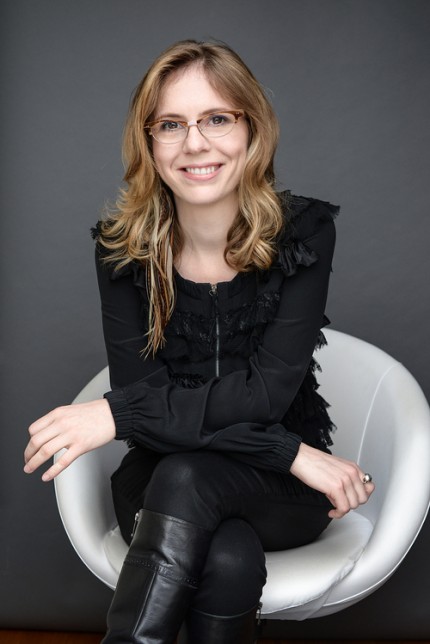Clyne’s intimate music lost in translation at Miller Theatre

Music of Anna Clyne was featured in the Composer Portrait series Thursday night at the Miller Theatre. Photo: Javier Oddo
Anna Clyne is one of the most interesting of the current group of composers under forty years old—she combines a taste for beauty with a command of organic form, and the craft to fill her structures with unexpected satisfactions. She has created lovely and gripping chamber and orchestral music for the likes of Jennifer Koh, Jody Redhage, the American Composers Orchestra and the Chicago Symphony Orchestra.
Clyne’s talent and accomplishments made this unsuccessful Composer Portrait at Miller Theatre Thursday night—the final one for the season—that much more frustrating and acutely disappointing.
There were four pieces on the program: three works for soloists or small ensemble in the first half, and three-fifths of a work in progress for singers and chamber ensemble in the second half. The conductor was Brad Lubman and Ensemble Signal provided the players. Every composition had some sort of electronic audio component. The compositions represented drastically different aspects of Clyne’s work, and the problems in the first half were different from the second.
In the first half, the pieces—Fits + Starts for solo cello, 1987 for mixed quartet, and Rapture for solo clarinet—all seemed hampered by their electronic component. The mix and interaction between instruments and electronics that works so well on records simply didn’t work in the hall.
In the space of one’s living room or through ear buds, the electronic sounds Clyne crafts are surprisingly and effectively intimate, while the instruments often seem to be the accompaniment. Live, the added visual element of the experience flips things around and the instrumentalists demanded attention. The speakers sat at each side of the stage, and they not only had no visual interest but separated the audio from the players so widely that there was no intimate connection. The two seemed to be silently struggling to find some reason why they were sounding together.
In Fits + Starts, cellist Lauren Radnofsky often was swamped by the mix. There was a strong oppositional quality in the music, with the audio goading the cellist forward with obsessive, mechanical rhythms, the cellist working up the confidence to rise above the textures with melancholic, lyrical lines. When Radnofsky did so, the music spoke eloquently, but most of the piece was murky.
Electronic sound, whether sampled or synthesized, is full of creative possibilities, but the ease of producing it can be a trap. Clyne made a track that combined her own recorded cello playing with digital sound, and the results were thin, the timbres canned. The contrast between the inherently interesting live instrument and the dull audio was uncomfortable. And the environment in which electronic composers work, using studio monitors or headphones to hear what they are doing, doesn’t automatically translate to the different acoustic properties of a performance hall.
The frustration was that, musically, the audio for Fits + Starts was well constructed as an accompaniment, and begs to be transcribed for chamber ensemble.
1987 suffered similarly. The live instruments were bass flute, violin, cello and bass clarinet, playing a quiet chorale that combined haunting intervals and satisfying harmonic motion. The piece was played in almost total darkness. The audio collected samples of kalimba-like sounds with a music box and environmental sounds that were personally important to Clyne. The problem with choosing sounds with such specific meaning to the composer is that it’s unlikely that they will trigger the same response, or anything at all, in the listeners—esepeically when compounded by the separation between the audience and the speakers. Sometimes, a carousel is just a carousel.
Rapture was more successful acoustically, because it blended prerecorded audio with real-time electronic modulation of Adrián Sandí’s clarinet. The clarinet repeated tense rhythmic figures, trying to break free of musical constraints. Finally, there was a brief, impassioned solo, something between free-jazz and metal, and Sandí’s playing was heroic.
The songs made up As Sudden Shut, a multi-media, animated opera, and the title and the words come from Emily Dickinson; “As Sudden Shut,” “The Lost Thought,” and “It’s coming-the postponeless Creature.” Sung by the trio of sopranos Mellissa Hughes and Jamie Jordan, and mezzo Kirsten Sollek, the music effectively transformed Dickinson’s aphoristic images into narrative drama. The results were monochromatic, three views of the same thing, but that was likely due to the limited amount of material.
What was troublesome was the music’s inability to break free from its large-looming influences, to sound in Clyne’s voice, rather than her channeling other music. The close, triadic vocal harmonies and rhythms were often a dead ringer for Steve Reich’s Proverb, there was a heavy coating of John Zorn’s structural juxtapositions, and there were even evocations of Goblin’s soundtrack for the Dario Argento film Suspiria and Bernard Herrmann’s work on Vertigo.
Lubman led a sharp performance, but the sound was again hampered by the mix. With more prerecorded audio, all the players were miked, and the instruments lost a lot of their natural richness. Worst off were the singers, excellent musicians, who sounded tinny through the speakers.
Clyne is a talented composer with a strong individual voice. Too bad this program did not present her work at anywhere near its best.
Posted Apr 24, 2015 at 7:58 pm by Mason Bates
The problem was the sound engineer, not the composer. Anna Clyne is one of the best handlers of electronic sound in classical music. I appreciate the kind words at start and end of the review but have to say, the body of the criticism is misdirected.